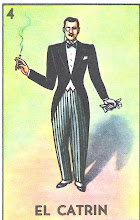i've been mia, reflecting on my time and work in brasil
and preparing for the upcoming interSEXtions conference happening this weekend
(organizingintersextions.blogspot.org)
but i came across this piece in my archives and thought i'd post it in a blog. it's an excerpt from my memoir...
...more on brasil is coming shortly.
--------------------------------
♫♪ Desde el cielo una hermosa mañana, desde el cielo una hermosa mañana, La Guadalupana, La Guadalupana, La Guadalupana bajo al Tepeyac…era Mexicana, era Mexicana, era Mexicana su porte y faz ♪♫. Every 12th of December was the only day of the year Papá would wake up early to go to church. We arrived at the church before 5:00 am to hundreds of believers who filled the church and crowded the street in front of the church, joyous and holding each other closely for warmth. They wore heavy layers of clothing to defend themselves from the violent Chicago winters. Winters whose skies are filled with snow, rain, and crushing wind; these conditions often provoked the Chicago Mexican to decipher whether leaving the motherland, where the summers were long and the winters were festive and full of familia, posadas, pozole y tequila to keep you warm, was the best choice.
We would find a place to sit or stand in the nave of the church or paint ourselves against a wall. The high pitch of my voice, my insistence on having hair that was longer than your typical boy, and my ways of seeing the world more from the eyes of my mother than from the eyes of my father made me feel like an art installation at a museum, rather than a painting resting against a church wall. The procession would begin with a nine-member mariachi leading the fellowship in singing Las Mañanitas: “This is the song of the sweet mornings King David would sing, since today is the day of your saint, we now sing this song to you, awaken my dear, awaken, look the morning has come, and the little birds are singing, and the moon has gone to sleep.” On those mornings, I stared in awe of the church filled with deeply reverent believers to the Virgen. I asked myself why did this event take place at 5am? Why were the only people who celebrated this holiday Mexican? And who is this saintly figure depicted in a framed painting we have come to put a crown on and praise? The image de nuestra virgen, like many other Catholic churches attended by Mexicans in this country, had made its way to a permanent corner in the church, separate from the chancel of the church, and would become the focal point of prayer for that morning in December. “Who is this woman my father and I have woken up so early in the morning to praise and call mother?”
(papí, did you miss your mother, mi abuelita? Is that why you beat mamí? Was mamí for you an image of a woman who was no longer a part of your life and beating her would bring your own mother out of her, back to life?)(Is this who the virgen has become for Mexicans who have migrated to the north -a surrogate mother?). (papí, why did you beat me when you found out I was gay? As a Queer man did you fear I wouldn’t represent your legacy? Did the continuation of the man you are/were die with my Queerness, and by beating me, were you trying to bring yourself back to life? Did you fear I was ending our Mexicanidad by adopting this “western” tradition? Tengo tu nombre pero no tu manera de ser.)
The Virgen appeared to Juan Diego on a morning in December more than 400 years ago, after Malinche had led the Spanish Conquistadores to the central basin of México to conquer Tenochtitlan. Malinche was a “prostitute” and “slave” to the Conquistadores. She spoke Nahuatl and Maya, learned Spanish and used language and sex to spin cultures together. Oh, how I worship her art. She gave birth to one of the first mestizos; Hernán Cortés was the father. From her birth canal was born a new breed of people made-up of equal parts of Spanish domination and indigenous subjugation, to form a species called resistance. Mexicans today are umbilically connected to La Malinche; our indigenous roots hang from her vagina and are embedded in her uterine imagination.
The oxymoronic Mexican accepts the Holy Trinity as a post-colonial treaty and La Virgen de Guadalupe is the condition under which Christianity is valued. Some say La Virgen is a mestiza version of the Virgin Mary. And this is a partial truth to México’s treaty to self. In an effort to save herself from colonization and European domination, Tonantzin, Coatlicue, the lunar mother goddess, the goddess of the lost and the abandoned, an indigenous goddess, appeared before Juan Diego. She asked him to gather flowers in his tilma on the hill of Tepeyac and to present the flowers to the Bishop Fray Juan de Zumárraga. In her ability to transform to the needs of those who needed her most, when Juan Diego presented the flowers he had gathered at the request of Tonantzin, before the Bishop was the image of a woman who was later named La Virgen de Guadalupe by the Church ♫♪ Era Méxicana, era Méxicana, era Méxicana su porte y su faz. ♪♫. She was Mexican, she was Mexican, she was Mexican, her demeanor and her face. ♪♫.
Tuesday, April 15, 2008
Subscribe to:
Posts (Atom)
